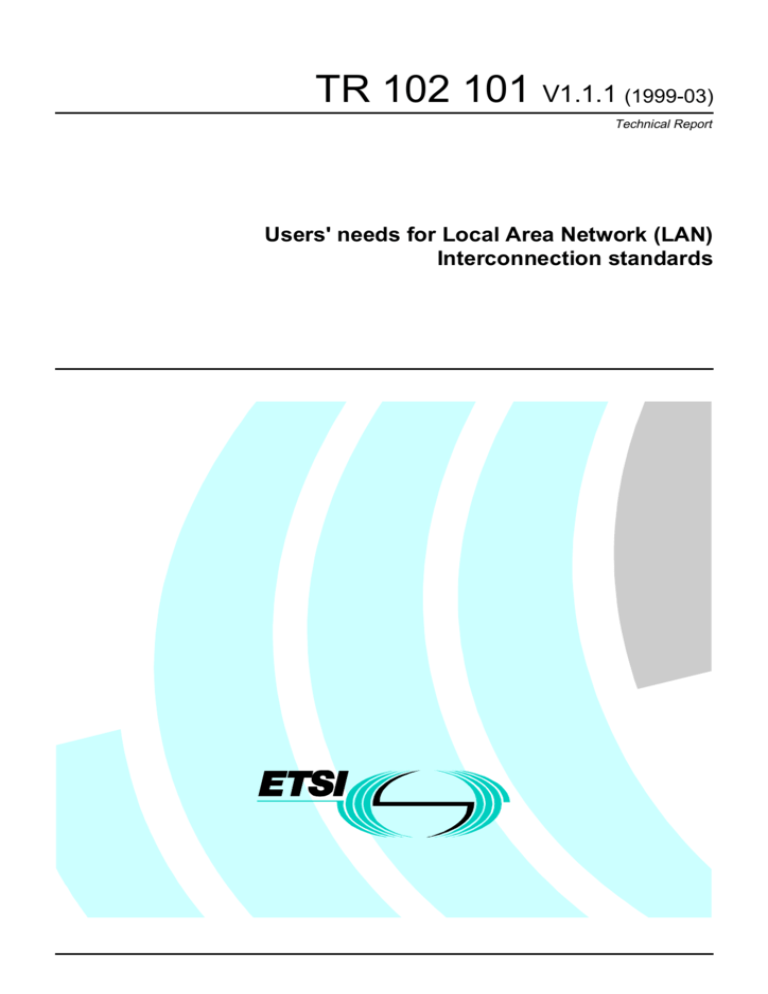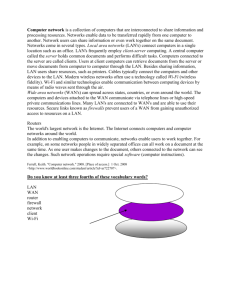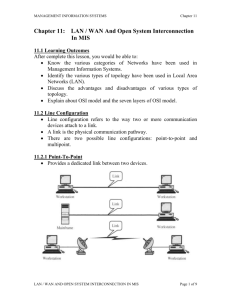
TR 102 101 V1.1.1 (1999-03)
Technical Report
Users' needs for Local Area Network (LAN)
Interconnection standards
2
TR 102 101 V1.1.1 (1999-03)
Reference
DTR/USER-00005 (jgc00ics.PDF)
Keywords
LAN
ETSI
Postal address
F-06921 Sophia Antipolis Cedex - FRANCE
Office address
650 Route des Lucioles - Sophia Antipolis
Valbonne - FRANCE
Tel.: +33 4 92 94 42 00 Fax: +33 4 93 65 47 16
Siret N° 348 623 562 00017 - NAF 742 C
Association à but non lucratif enregistrée à la
Sous-Préfecture de Grasse (06) N° 7803/88
Internet
secretariat@etsi.fr
Individual copies of this ETSI deliverable
can be downloaded from
http://www.etsi.org
If you find errors in the present document, send your
comment to: editor@etsi.fr
Copyright Notification
No part may be reproduced except as authorized by written permission.
The copyright and the foregoing restriction extend to reproduction in all media.
© European Telecommunications Standards Institute 1999.
All rights reserved.
ETSI
3
TR 102 101 V1.1.1 (1999-03)
Contents
Intellectual Property Rights ............................................................................................................................... 4
Foreword ............................................................................................................................................................ 4
Introduction........................................................................................................................................................ 4
1
Scope........................................................................................................................................................ 5
2
References ............................................................................................................................................... 5
3
Definitions and abbreviations.................................................................................................................. 5
3.1
3.2
4
4.1
4.2
4.3
4.3.1
4.3.2
4.3.3
5
5.1
5.2
5.3
5.4
5.5
6
Definitions ......................................................................................................................................................... 5
Abbreviations..................................................................................................................................................... 5
Standards Applicable to LAN Interconnection ....................................................................................... 6
Standards Bodies involved in LAN Interconnection.......................................................................................... 6
Interfaces used in LAN Interconnection ............................................................................................................ 7
Protocols used in LAN Interconnection............................................................................................................. 7
Communications (Lower Level) Protocols used in LAN Interconnection.................................................... 7
Bridging, Routing and Application (Higher Level) Protocols used in LAN Interconnection....................... 7
Network Management Protocols used in LAN Interconnection ................................................................... 7
Users' views on the need for Standards in the LAN Interconnect Arena ................................................ 8
User 1: A Telecom Consultant specialist in network design and development.................................................. 8
User 2: A Telecom Manager for a large Multi-national and a member of a European User Group................... 8
User 3: A Telecom Development Manager for a large Multi-national .............................................................. 8
User 4: A Network Architecture Designer for a large University ...................................................................... 8
A Suppliers' view: From a Large international supplier of networking equipment ............................................ 9
Résumé of Users' views on the need for Standards in the LAN Interconnect Arena .............................. 9
Annex A (informative):
The OSI Reference Model ............................................................................ 10
Annex B (informative):
Notes on LAN Interconnection devices ....................................................... 12
B.1
Repeaters ............................................................................................................................................... 12
B.2
Bridges................................................................................................................................................... 12
B.3
Routers................................................................................................................................................... 13
B.4
Gateways................................................................................................................................................ 14
History.............................................................................................................................................................. 15
ETSI
4
TR 102 101 V1.1.1 (1999-03)
Intellectual Property Rights
IPRs essential or potentially essential to the present document may have been declared to ETSI. The information
pertaining to these essential IPRs, if any, is publicly available for ETSI members and non-members, and can be found
in SR 000 314: "Intellectual Property Rights (IPRs); Essential, or potentially Essential, IPRs notified to ETSI in respect
of ETSI standards", which is available free of charge from the ETSI Secretariat. Latest updates are available on the
ETSI Web server (http://www.etsi.org/ipr).
Pursuant to the ETSI IPR Policy, no investigation, including IPR searches, has been carried out by ETSI. No guarantee
can be given as to the existence of other IPRs not referenced in SR 000 314 (or the updates on the ETSI Web server)
which are, or may be, or may become, essential to the present document.
Foreword
This Technical Report (TR) has been produced by ETSI Special Committee User Group.
Introduction
Local Area Networks (LANs) were developed following the advent of the desktop computer (or personal computer), in
response to desktop computer users’ need to have access to more services and resources than could be provided by a
single stand alone computer (mainframe computer users already had star networks for connection of their desktop
terminals to the host computer). These services and resources were initially contained within a small area, e.g. an office,
a factory, or a single building. It soon became apparent that users also needed to have access to other LANs either in
different locations within their own company or within other companies. Connection to remote networks was first made
possible by using quite unwieldy dial-up methods soon followed by the advent of LAN interconnection either via a high
speed data link within the same site or Metropolitan Area or via a Wide Area Network (WAN) to more distant locations
anywhere in the world. Therefore a series of LAN interconnect devices were developed to address various
interconnection tasks.
There are four basic types of LAN interconnection devices:
-
repeaters;
-
bridges;
-
routers; and
-
gateways.
A set of definitions are provided in subclause 3.1, with further information in annex B. These definitions follow the
Open System Interconnection (OSI) Reference Model developed by the International Standards Organization (ISO), i.e.
device types are defined by the OSI layer(s) at which the interconnection function is performed. A definition of the OSI
Reference Model is given in annex A.
ETSI
5
1
TR 102 101 V1.1.1 (1999-03)
Scope
The present document identifies the users' requirements regarding the standardization needs in Local Area Network
Interconnection as seen through a survey carried out by the ETSI User Group in 1998.
2
References
The following documents contain provisions which, through reference in this text, constitute provisions of the present
document.
• References are either specific (identified by date of publication, edition number, version number, etc.) or
non-specific.
• For a specific reference, subsequent revisions do not apply.
• For a non-specific reference, the latest version applies.
• A non-specific reference to an ETS shall also be taken to refer to later versions published as an EN with the same
number.
[1]
Void.
3
Definitions and abbreviations
3.1
Definitions
For the purposes of the present document, the following terms and definitions apply:
repeater: a device connecting two LAN segments at the Physical layer (layer 1) of the OSI Reference Model.
bridge: a device interconnecting two LANs at the Data Link layer (layer 2) of the OSI Reference Model.
router: an inter-networking device (i.e. operates at the Network layer (layer 3) of the OSI Reference Model) that
dynamically routes frames based upon specific criteria optimizing the use of the networks between frame source and
destination.
gateway: a device, interconnecting otherwise incompatible networks or network devices at the upper layers (layers 4
to 7) of the OSI Reference Model.
3.2
Abbreviations
For the purposes of the present document, the following abbreviations apply:
ANSI
ATM
BGP
CMIP
COS
DECnet
DNA
ECMA
EGP
ES-IS
GOSIP
IEEE
IETF
American National Standards Institute
Asynchronous Transfer Mode
Border Gateway Protocol
Common Management Information Protocol
Corporation for Open Systems
Digital Equipment Corporation proprietary protocol
Digital Network Architecture
European Computer Manufacturers Association
Exterior Gateway Protocol (CISCO proprietary protocol)
End System to Intermediate System protocol
Government Open Systems Communications Interconnection Profile
Institute of Electrical and Electronics Engineers
Internet Engineering Task Force
ETSI
6
IGP
IGRP
IPX/SPX
ISDN
IS-IS
ISO
ITU-T
LAN
NIST
NNI
OSF
OSI
OSPF
PPP
RFC
RIP
RS-232
RSVP
RTMP
SNA
SNMP
T1/E1
Interior Gateway Protocol (CISCO proprietary protocol)
Interior Gateway Routing Protocol (CISCO proprietary protocol)
Internet Packet Exchange/Sequenced Packet Exchange
Integrated Services Digital Network
Intermediate System to Intermediate System
International Standards Organization
International Telecommunications Union - Telecommunications sector (was CCITT)
Local Area Network
National Institute for Standards and Technology
Network-to-Network Interface
Open Systems Forum
Open Systems Interconnection
Open Short Path First
Point-to-Point serial-line Protocol (IETF)
Request For Comments (IETF)
Routing Information Protocol
identical to V.24 (ITU-T) and ISO 2110
Resource ReSerVation Protocol (IETF)
Remote Table Maintenance Protocol
System Network Architecture (IBM proprietary protocol)
Simple Network Management Protocol (IETF)
1,544 Mb/s (North America) / 2,048 Mb/s (Europe) time-multiplexed connection (defined in
ITU-T Recommendations G.702 and G.703)
Transmission Control Protocol/Internet Protocol
UNIX International
Analogue modem connection (identical to ISO 2110)
Asynchronous connection at 48/56/64 kb/s
Wide Area Network
Digital synchronous connection to public provided services such as X.25
ITU-T Recommendation for Packet Switched Networks
ITU-T Recommendation for interconnection of Message Handling Systems
Xerox (Inc.) Network Systems protocol (Xerox proprietary protocol)
TCP/IP
UI
V.24
V.35
WAN
X.21
X.25
X.400
XNS
4
TR 102 101 V1.1.1 (1999-03)
Standards Applicable to LAN Interconnection
The standards applicable to LAN interconnection over WANs are in three areas: interfaces, protocols and management.
Standards come in many forms: de facto, de jure, International, European, proprietary, etc.
4.1
Standards Bodies involved in LAN Interconnection
There are many standards bodies involved in the LAN interconnection over WANs. Listed here are the major ones.
ANSI
ATM Forum
COS
ECMA
GOSIP
IEEE
IETF
ISO
ITU-T
NIST
OSF
UI
American National Standards Institute
Asynchronous Transfer Mode Forum
Corporation for Open Systems
European Computer Manufacturers Association
Government Open Systems Communications Interconnection Profile
Institute of Electrical and Electronics Engineers
Internet Engineering Task Force
International Standards Organization
International Telecommunications Union - Telecommunications sector (was CCITT)
National Institute for Standards and Technology
Open Systems Forum
UNIX International
Proprietary standards are produced by a number of manufacturers, among these are CISCO, Wellfleet, Hewlett Packard,
Digital Equipment Corporation, IBM, etc.
ETSI
7
4.2
TR 102 101 V1.1.1 (1999-03)
Interfaces used in LAN Interconnection
Interfaces are used to connect a system to the media carrying the data traffic.
The interface standards used in interconnect are generally well known and well specified.
Examples of such interfaces are:
T1/E1
V.24,
V.35
X.21
4.3
1,544 Mb/s (North America) / 2,048 Mb/s (Europe) time-multiplexed connection (defined in
ITU-T Recommendations G.702 and G.703)
Analogue modem connection (also known as ISO 2110 or RS-232)
Asynchronous connection at 48/56/64 kb/s
Digital synchronous connection to public provided services such as X.25
Protocols used in LAN Interconnection
Protocols are the defined procedures or rules by which systems communicate with each other.
The following protocols are widely used in LAN interconnect:
4.3.1
ATM
DECnet
IPX/SPX
ISDN
PPP
SNA
TCP/IP
X.25
XNS
4.3.2
BGP
EGP
ES-IS
IGP
IGRP
IS-IS
OSPF
RIP
RTMP
4.3.3
CMIP
SNMP
Communications (Lower Level) Protocols used in LAN
Interconnection
Asynchronous Transfer Mode
Digital Equipment Corporation proprietary protocol
Internet Packet Exchange/Sequenced Packet Exchange
Integrated Services Digital Network
Point-to-Point serial-line
System Network Architecture (IBM proprietary protocol)
Transmission Control Protocol-Internet Protocol
ITU-T Rec. for Packet Switched Networks
Xerox (Inc.) Network Systems protocol (Xerox proprietary protocol)
Bridging, Routing and Application (Higher Level) Protocols used in
LAN Interconnection
Border Gateway Protocol
Exterior Gateway Protocol (CISCO proprietary protocol)
End System to Intermediate System protocol
Interior Gateway Protocol (CISCO proprietary protocol)
Interior Gateway Routing Protocol (CISCO proprietary protocol)
Intermediate System to Intermediate System
Open Short Path First
Routing Information Protocol
Remote Table Maintenance Protocol
Network Management Protocols used in LAN Interconnection
Common Management Information Protocol
Simple Network Management Protocol
ETSI
8
5
TR 102 101 V1.1.1 (1999-03)
Users' views on the need for Standards in the LAN
Interconnect Arena
This clause contains a selection of views obtained from a survey of the User community.
5.1
User 1: A Telecom Consultant specialist in network design
and development
My feeling is that people like myself, designing large networks for clients, are not really interested in the standards for
interconnect. Our major interest is in the functionality and interoperability provided by a specific supplier of the
hardware and software.
When designing a network we look at the user requirements and then match these against a supplier’s offerings. We
always try to keep to one supplier for a single network. This reduces the need to overcome problems such as software
bugs and hardware glitches.
The major sources of internetworking data regarding protocols are the Internet engineering groups.
5.2
User 2: A Telecom Manager for a large Multi-national and a
member of a European User Group
LAN-to-LAN connection across wide area IP networks is now the requirement for multinationals, in support of their
Intranets.
The need for standards is less clear, given the existing initiatives for Frame Relay interconnect (NNIs et al.), ATM
interconnect (various initiatives) and the development of the IP standards (RSVP et al.).
It might be useful to have some agreed performance measures latency, ping time, maximum hop count etc., but these
seem to be in the commercial domain for negotiating with Global Network suppliers, unless benchmarkability becomes a
legal requirement (unlikely).
Any standards would only be of use if international not European.
Therefore I see little need for ETSI to be active in this area, but I may be mistaken.
5.3
User 3: A Telecom Development Manager for a large Multinational
I believe that people in my company are now used to using LAN interconnects and do not require further standards or
the present standards made more clear. The standard LAN/WAN technologies deployment is now well understood and
people are now more interested in areas like remote access, encryption, authentication, network security, firewalls, etc.
5.4
User 4: A Network Architecture Designer for a large
University
LANs and their layer 2 interconnects are by definition of Local interest, i.e. not involving more than one organization;
therefore their standardization by a body set up to deal with public networks is a diversion. Industry standards do exist; a
lot of them; in fact, too many.
Routers are less of a LAN and more of a WAN issue; but they, too, are fully covered by IETF de facto standards in the
form of RFCs. Statutory standardization would be futile if different and redundant if not. ETSI can simply select RFCs
and adopt them; and so can the ISO, in preference or in parallel to the classic OSI standards.
Perhaps ETSI should stick with public telecommunications (including ATM) and leave frame based data
communications (i.e. LANs and router based LANs) well alone.
ETSI
9
TR 102 101 V1.1.1 (1999-03)
I think I understand your ToRs but I'm afraid the objectives of your project are unclear to me. As a practising Network
Architect designing and building very large and complex networks I can assure you that ETSI is not the organization to
which I would look for LAN standards; and neither is the ISO. I stick with the Internet crowd which does original work.
5.5
A Suppliers' view: From a Large international supplier of
networking equipment
I do recognize the value that the ETSI Users Group brings to the ETSI community by investigating issues that may result
in a need for European Standards.
However, in the case of LAN interconnection, which is an area where my company has been active for a long time, we
do not believe that there is a need for standardization in ETSI.
LAN Interconnection standards, by their very nature, need to be International Standards, and it would be detrimental to
the whole IT community if they were to be defined in a regional body.
Standards for LAN Interconnection are being elaborated by IETF, and my company is of the opinion that the present
state of standardization in this area is fully satisfactory.
The IETF is a fully recognized, international, open body with active participation of all the leading companies in the
field, whether based in Europe or in other parts of the world.
Many ETSI members, as well as ETSI itself, participate in IETF. The IETF specifications are freely available (see
http://www.ietf.org/). We recommend that the result of your investigations on user requirements in this area be fed into
IETF only.
6
Résumé of Users' views on the need for Standards in
the LAN Interconnect Arena
People working in the Network arena are now well versed in LAN interconnects and do not require further standards or
the present standards made more clear.
The standard LAN/WAN technologies deployment is now well understood and people are now more interested in areas
like remote access, encryption, authentication, network security, firewalls, etc.
Industry standards to interconnect LANs do exist; a lot of them; in fact, too many.
Designers of networks are not really interested in the standards for interconnect. their major interest is in the
functionality and interoperability provided by a specific supplier of the hardware and software.
When designing a network the designers look at the users’ requirements and then match these against a supplier’s
offerings. They always try to keep to one supplier for a single network. This reduces the need to overcome problems
such as software bugs and hardware glitches.
The major sources of internetworking data regarding protocols are the Internet Engineering Groups (IETF).
LAN interconnect is fully covered by IETF de facto standards in the form of RFCs. Statutory standardization would be
futile if different and redundant if not. ETSI can simply select RFCs and adopt them; and so can the ISO, in preference
or in parallel to the classic OSI standards.
It might be useful to have some agreed performance measures latency, ping time, maximum hop count etc., but these
seem to be in the commercial domain for negotiating with Global Network suppliers, unless benchmarkability becomes a
legal requirement (unlikely).
Any standards would only be of use if international not European.
Therefore there seems to be little need for ETSI to be active in this area.
ETSI
10
TR 102 101 V1.1.1 (1999-03)
Annex A (informative):
The OSI Reference Model
The Open systems Interconnection (OSI) Reference Model defines seven communication levels that provide specific
functions required for two systems to exchange data via some medium or linked media. A system in this context is
defined as a set of one or more computers and their software, peripherals, users, etc., that make up a single information
processing unit. Such a system is "open" if it can interwork with other systems using "OSI" standards, i.e. whose
specifications conform to the functional layering defined in the OSI model.
The first concept introduced by the model is that of layering, which separates communications oriented functions and
their related protocols from processing oriented functions and higher level protocols. Each system is composed of
subsystems in a hierarchy such that the services offered by one subsystem are provided only to the next higher level
subsystem and direct the services of the next lower subsystem. Subsystems of the same rank form a layer. The respective
elements of each layer in two end systems co-operate to provide services to the next higher layer. To do so, they
communicate using the services of the next lower layer, except of course at layer 1, where they communicate directly
using physical media.
It follows that a change to a particular layer need not affect the standards appropriate to other layers provided the
interface remains compatible.
In addition to providing basic data transfer, a layermay provide a number of other functions, depending on the nature of
the service it is offering and that offered to it by the layer below, such as:
-
error detection, acknowledgement and error correction, dealing with the loss of data units;
-
sequencing, dealing with the ordering of blocks of data;
-
resetting, allowing the data flow to be set to a known state;
-
multiplexing, allowing a number of connections to be supported by a single connection provided by the next
lower layer (for cost efficiency);
-
splitting, allowing a single connection to be supported by a number of connections provided by the next lower
layer (for increased performance or reliability).
It is not always possible to establish direct connection between two entities in a layer through the next lower layer, e.g. if
there is no direct physical medium connecting the systems in which they are located. In such a case, communication
takes place through intermediate entities in the layer, which provide routing and relaying of the data, e.g. through the
nodes of a packet switching network.
Finally, there is the vital need for management of the interconnected systems making an "OSI" environment and for
corresponding Protocols. These are not only for "human" and "network" management in the traditional sense, but also
for monitoring and co-ordination of the activities of the layers and of application processes, e.g. for addressing and
directory functions and for the handling of abnormal conditions.
Network-dependent layers
Layers 1 to 3 of the model are referred to as network-dependent because they are the only layers affected by the
characteristics of the transmission facilities employed, i.e. direct link, private network, public network, etc. As such, they
have to support a range of different alternative protocols. Above layer 3, connections are between end systems only and
thus are concerned with the nature of communications rather than how the links are achieved. Layers 1 to 3 enable
layer 4 to achieve inter-connection in terms of reliable data transfer; layers 5 to 7 are focused on interworking between
application processes.
Physical layer (1)
The physical layer provides the means to transfer data in the form of binary digits over a continuous physical
communications path and is thus concerned with the electrical and mechanical requirements of such transmission and of
system activation and deactivation.
NOTE:
Standards covering electrical characteristics, voltage levels, earthing arrangements, mechanical
specifications, pin connector design, cable lengths, timing, data rates and so on are fairly well established.
ETSI
11
TR 102 101 V1.1.1 (1999-03)
Data-Link Layer (2)
The data-link layer provides "framing", i.e. the determination of which electrical or other signals represent bits and
characters, for data transfer across a physical connection, and provides some error detection and recovery. Where
recovery is not possible, the network layer is notified of the error. The data-link layer may use more than one physical
connection to support a single data-link connection and in such cases will be responsible for ensuring that data are
delivered to the network layer in correct order. Where a continuous physical medium connects more than two
end-systems, e.g. a local area network, the data-link layer may include a Medium Access Control function, e.g.
CSMA/CD and token-passing protocols for local area networks.
Network Layer (3)
The basic function of the network layer is the interconnection of data-link communication paths into a global network
which connects all open systems. Thus, the network layer performs both end-to-end addressing and routing functions, to
enable the end systems to exchange data. This implies that network addresses are globally unique.
Transport Layer (4)
The transport layer can be regarded as providing a reliable, network independent, end-to-end service. In addition,
facilities are available for optimizing network costs, e.g. by multiplexing several transport connections onto a single
network connection, or quality of service, including the ability to use several network connections to carry the load of a
single transport connection.
Session Layer (5)
The session layer provides dialogue management which enables communicating application processes to exchange
information. It negotiates the type of interaction to be used, e.g. simultaneous, two way alternate, etc., at the time of
session establishment. It then controls access to services. The most fundamental aspects of such control are concerned
with data flow direction and with ensuring an orderly end of a communication once all data have arrived and been
accepted at the destination. The session layer can also provide a data recovery service in the event of data loss or
temporary failure of any component in the communication path.
Presentation Layer (6)
The presentation layer is responsible for making the information transferred comprehensible to the receiving system.
Tasks performed by this layer include data conversion/encoding, data compression and data encryption. Each system can
have its own particular encoding rules and data structures. The presentation layer allows two end systems to share a
common format, which can then either be used directly or be converted by one or both of the end systems for internal
use.
Application Layer (7)
The application layer provides the interface between the OSI communications environment and the application
processes using it. It provides a set of common application service elements for management and activation of resources
in support of the communication.
ETSI
12
TR 102 101 V1.1.1 (1999-03)
Annex B (informative):
Notes on LAN Interconnection devices
B.1
Repeaters
By transferring bits from one LAN segment to another a Repeater makes two segments logically appear to be one.
Thanks to Repeaters a single LAN can be built by joining several LAN segments, thus overcoming cable length
limitations that are imposed to avoid problems such as signal loss and timing dispersion.
B.2
Bridges
Bridges make a number of LANs appear to be one virtual network. Bridges are store and forward devices which accept a
complete frame of data, check its validity and destination before passing it to the appropriate physical layer link. They
may perform in 3 different modes within a network: Forwarding, Filtering and Learning. In Forwarding mode they pass
data frames to other networks. In Filtering mode they discriminate between local and remote data destinations: data
frames addressed to local devices are discarded, thus the local traffic remains confined to the network where it is
originated. Therefore Bridges can be used to connect networks with different OSI layer 2 protocols, e.g. a Token Ring
network and an Ethernet network. In Learning mode a Bridge automatically updates its address tables when a new
device is added or a device is removed from the network.
Bridges can be specified in many different forms: by Protocol, by Geographical Location or more commonly by Type,
i.e. by the way they perform their allotted tasks.
Specification by protocol:
-
Like protocol Bridges: only work with networks using the same protocol e.g. Ethernet to Ethernet or Token Ring
to Token Ring.
-
Unlike protocols Bridges: connect networks using different protocols e.g. Ethernet to Token Ring.
Specification by Geographical Location:
-
Local Bridges: connect LANs in close proximity. The major advantage of Local Bridges is that they separate and
isolate the traffic from one network to another.
-
Remote Bridges: connect LANs that are geographically separated even by thousands of miles.
Specification by Type:
There are 4 major types of Bridges:
-
Transparent Bridges (or Spanning Tree Bridges): can only be used to connect LANs that use the same Physical
medium and Data Link protocol (i.e. Ethernet to Ethernet, Token Ring to Token Ring etc.).
-
Translating Bridges: translate from one LAN format to another. Therefore they can be used to connect LANs
with different physical media and different Data Link Protocols (e.g. Ethernet to Token Ring).
-
Encapsulating Bridges: provide a network interconnection by encapsulating data frames in an envelope before
forwarding the envelope to another Bridge for delivery. Thus a number of LANs can be interconnected over a
single medium (e.g. several LANs over a single fibre optic (FDDI) cable).
-
Source Routing Bridges: decide where the frames are to be forwarded to and route them accordingly, thus
improving the efficiency of the traffic between the networks. They are the most sophisticated type of Bridge.
NOTE:
Some Bridges can include the characteristics of another type, e.g. Source Routing Transparent Bridges.
ETSI
13
B.3
TR 102 101 V1.1.1 (1999-03)
Routers
The main function of a Router is for it to transfer data from Local Area Network A to Local Area Network B wherever
Local Area Network B is located. A Router therefore carries out a number of functions similar to those of a Bridge but
has enhanced address and protocol handling facilities. It can be either connection oriented or connectionless oriented. In
general Routers can handle more than one networking protocol and are able to support large network configurations in
both connection and traffic aspects, which makes them suitable to multi site, multi protocol usage. More recently they
have become used for Bandwidth on Demand routing whereby routes and networks are used based upon the bandwidth
required.
NOTE:
A hybrid device called a B-Router has appeared on the market in recent years; it is a combination of a
Bridge and a Router.
Routers can be of several types, as specified by Geographical Location, by Administration Method, by Protocols
supported, by Application etc.
Specification by Geographical Location:
-
Local Routers: can provide a very useful Local facility for connecting Host computers which are connected to
LANs. Using their multi protocol ability they can be used, for example, to connect Host computers from one or
several vendors together.
-
Remote Routers: can be a used to perform high volume distributed processing whereby the processing is carried
out wherever, on the network, it is the most suitable place to perform that particular process.
Specification by Administration Method:
The way the Routing address tables are administered can be either Centralized or Decentralized and either Static or
Dynamic.
-
Centralized operation: whereby the routing tables are maintained for the whole network at one central location.
The centrally located Router keeps all the other Routers in the network informed about the network
configuration.
-
Decentralized operation: whereby the routing tables are kept locally and therefore distributed throughout the
network. In this scenario each Router informs its neighbours (i.e. the Routers or networks connected to it) of its
configuration thus each Router on the network knows about all the others in a piecemeal formation.
-
Static Routing (or Fixed Routing): whereby the network definition tables are created and maintained by a
network management system thus they can only be changed when the network is closed down or non-operational.
-
Dynamic Routing: whereby the Routers themselves automatically update each other thus allowing systems to be
removed and added without the necessity to close down the network.
Specification by Protocols supported:
A Router can be either single or multi protocol.
-
Single protocol Routers: can only handle a single protocol at any one time. These devices are most often used as
interconnection devices within a single supplier’s network.
-
Multi protocol Routers: can handle a number of different protocols at any one time e.g. SNA, DNA, TCP/IP, etc.
Specification by Application:
EXAMPLE:
Segment Isolation Routers are used to separate the sections of a single backbone network into
individual sections. This allows for easier maintenance and troubleshooting.
ETSI
14
B.4
TR 102 101 V1.1.1 (1999-03)
Gateways
Gateways are translation devices from one network protocol to another, e.g. SNA to TCP/IP. Gateways are often used to
interconnect at the application layer (layer 7), e.g. they can be used to interconnect an X.400 Email system and an IBM
PROFS (Professional Office System) Email system.
ETSI
15
History
Document history
V1.1.1
March 1999
Publication
ISBN 2-7437-2854-X
Dépôt légal : Mars 1999
ETSI
TR 102 101 V1.1.1 (1999-03)









![Internetworking Technologies [Opens in New Window]](http://s3.studylib.net/store/data/007474950_1-04ba8ede092e0c026d6f82bb0c5b9cb6-300x300.png)
